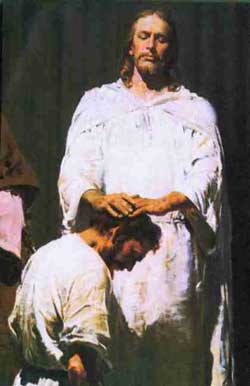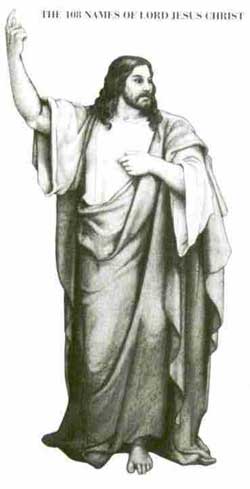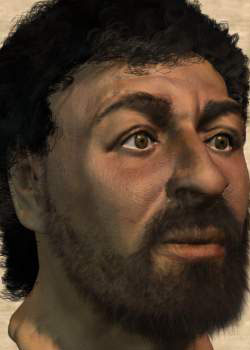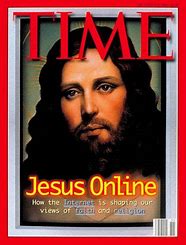"There's something in us that will not rest until we have a clearer picture of the one Christians revere as the very Son of God. Biblical affirmations, theological statements, creeds and sermons, however effective, still leave us with that elementary desire. We'd like to have a sharper image and a closer knowledge of this man whom we call the Savior of the world."
A few years later on July 10 1998 at 3:50 p.m., after Kash's eight-year-old brother Arwinder Singh had returned from Victor-Thérien school, he was shown the color photograph of Lord Jesus from the Mormon Bible (see photo on the left). Arwinder, at the age of five had met the messengers of God hundreds of times in the Kingdom of God (Sahasrara Chakra) within. Among these Divine Beings was Lord Jesus Christ.
This particular photograph of Lord Jesus is on the first page of The Book of Mormon: Another Testament of Jesus Christ (The Church of Jesus Christ of Latter-day Saints, Salt Lake City, Utah, USA, 6/94). Two young Mormon Christians, Elder Carpenter and Walter, gave this Bible to his father in 1995 while on house visits. They were operating from 570 Apt. 104, 33rd Avenue, Lachine, Montreal (Tel: [514] 634-4693). (At the time of writing other Mormons had replaced them but the address remains the same.)
After Arwinder had a good look at the photograph of Lord Jesus, his father asked him the following questions:
Question: "Have you seen this person?"
(Arwinder remains silent for a few seconds as he observes the face.)
Question: Did you see this man?"
Arwinder: "Yes, but I don't know his name."
Question: "Where did you see Him?"
Arwinder: "In my meditation."
Question: "Was it with Shri Mataji?"
Arwinder: "Yes."
Question: "Arwinder, this man, His name is Jesus Christ.
Is He big-sized or small-sized?"
(Arwinder was all the while shown the Mormon bible photograph clearly showing an average-sized Christ.)
Arwinder: "Big-size."
(Despite photographic evidence right before him to the contrary Arwinder still replied that Lord Jesus was big- sized!)
Question: "What color dress does He normally wear?"
Arwinder: "Let me think."
(He closed his eyes for a few seconds before replying.)
"White"
Question: "How long is the dress? until here? the knees? or down here?"
(His father pointed out the waist-level, knee-level and ankle-level.)
Arwinder: "Down here"
(He pointed to and held his ankles)
Question: "Arwinder, did you talk to him?"
Arwinder: "Yes."
Question: "What did you talk to Him?"
Arwinder: "I don't know. I forgot. Some I forgot."
Question: "What language did Lord Jesus Christ talk with you?"
Arwinder did not understand the meaning of language and it was explained to him.
Arwinder: "Like how I talk." (i.e., in English.)
Question: "What language did He talk with the others."
Arwinder: "Different."
Question: "What you mean 'different'?"
Arwinder: "Like Punjabi."
(This probably is Sanskrit as he, having heard Punjabi being spoken at home and which he does not understand, thought it to be similar. The point is that it is like Punjabi, not Punjabi.)
The fact that Shri Jesus spoke with the other Divine Beings in Sanskrit will profoundly enlighten those who contemplate in silence the sheer depth of this Revelation, which reveals that Shri Jesus is part and parcel of the Sanatana Dharma, even claiming to have existed before Abraham, a declaration not taken lightly by fellow Jews.
Then said the Jews unto him, thou art not yet fifty years old, and hast thou seen Abraham? Jesus said unto them: Verily, verily, I say unto you, before Abraham was, I am. Then they took up stones to cast at him. ( John 8: 57-9)
According to Shri Mataji Jesus was already existing eons ago at the very beginning of Creation itself. The history of the Divine is far more ancient than the billions of years it took for this Earth to come to its present form. It is the endless birth and dissolution of universes that constitutes Time.
So how old is the Universal Savior? Why is He witnessed mingling with Shri Ganesha, Rama, Krishna, Shiva, Brahma, Vishnu and other extremely ancient Vedic Supreme Beings who have been existing since the Dawn of Creation?
Meditation on these questions with an attendant discernment of deep spiritual answers will lead the person to forever free themselves from the clutches of reigning religious regimes and to merge with Cosmic Consciousness. A five-year-old child, instantly enlightened by the Kundalini awakening of the Holy Spirit Shri Mataji Nirmala Devi, is insisting that all His Messengers in the Kingdom of God are in perfect harmony! Why are innocent children insisting on the Divine Unity of all Messengers in the Kingdom of God, while adult followers of religious regimes continue rejecting it despite all their lip-service?
On September 24, 1996 at 6:40 p.m., after having performed aarti, Arwinder was shown the black and white photograph of Shri Jesus Christ as described by Shri Mataji (left).
This particular photograph, shown to him for the first time, is on page 128 of the Sahaja Yoga Mantra Book (Second Edition [Revised] 1992). Before this he had already identified that the figure in page one of the Mormon Bible, The Book of Mormon: Another Testament of Jesus Christ, as that of Lord Jesus.
These questions were then put forward:
Question: "Have you seen this man before? Do you recognize his face?"
Arwinder: "Yes, in my meditation."
Question: "Arwinder, are these two people the same or different?"
Arwinder: "The same."
It has to be pointed out that there are fundamental differences between the Mormon Church's portrait of Jesus and that depicted by Shri Mataji Nirmala Devi with regard to build, height, skin color, facial features, posture and dress, not to mention the further difficulty presented by one being in color and the other in black & white.
Despite these variances, Arwinder claimed that both portraits were of the self-same person he saw in his Sahasrara!
On February 1, 1997 at 10:35 a.m. Arwinder was shown the front page and related cover story: 'Jesus OnLine' in the December 26, 1996 TIME magazine, where the pictures of Shri Jesus were similar to the one on the left, below.
However, this time he was not sure if he had seen that face anywhere.
When reminded that it was that of Shri Jesus he said no, that was not the face of Jesus.
Kash, who was sitting nearby and following the discussion, intervened and told his father that the picture on the front cover of the TIME magazine was not that of Shri Jesus, and that was why Arwinder was saying so. However, when they were shown the photo of Jesus Christ in the Mormon Bible, both agreed that it was that of Lord Jesus!
Not even twenty centuries after the birth of Lord Jesus Christ, is the Church able to despite the greatest of Renaissance artistic talent. Nor has a single pope, ayatollah, or dalai lama met and described Lord Jesus. Yet, children born again of the Spirit within visit Him almost daily in the Kingdom of God, within their own being!
These mystical experiences really do serve to remind one of the severe limitations of organized religion in ascertaining the truth — i.e., Truth with a capital T. Shri Mataji called that kind of truth 'the Absolute Truth' that never changes and does not die. That is the truth of the Spirit/Spirit world and all it entails. Jesus said: "If you abide in my word, then you are truly disciples of mine; and you shall know the truth, and the truth shall make you free." (John 8:31). So, what kind of truth is an organized religion that binds a man to a creed or doctrine, rather than setting him free? The mystical truth of the Kingdom of God exposes the utter spiritual bankruptcy of all these religious regimes, and sets in motion their destined demise in this century, as increasing numbers of truth seekers disentangle themselves and flee from them, preferring to seeks disentangle sets in motion and exposes most definitely implies the utter spiritual bankruptcy of all these religious regimes and their destined destruction in this century, as increasing numbers of the seekers of the truth disentangle themselves and flee from them, preferring to seek the Kingdom of God within themselves!
The inherent spiritual dimension within humanity is not the exclusive property of any one religion or spiritual tradition, nor is this dimension inevitably awakened by binding oneself to a particular religious or spiritual belief. Rather, this practical path which requires the actions of purification and transformation is available to anyone who actively and earnestly seeks it. As such, it is a specific, definite and tangible spiritual path that eradicates all the ambiguity and vague subjectivity, sadly so prevalent in much of modern spirituality. Although it has been described in various ways in different ages, traditions, symbols, etc., the Kingdom of God is universally regarded as the inner core of ultimate Enlightenment.
Not only will humans be able to evolve by seeking the Kingdom of God within, but they will in this lifetime live the very means to achieve the Resurrection, provided they approach it in the correct way. This is possible if they use the knowledge, techniques and practices revealed by the Great Adi Shakti Shri Mataji Nirmala Devi in order to comprehend the Kingdom of God, a profoundly mystical subject about which Christian theologians with their incomprehensible contradictions reveal they have not a clue!
[In fact, their contradictory, incomprehensible statements and explanations leave one intellectually drained, confused and doubtful. For example, just try to understand what Professor William Lane Craig, Research Professor of Philosophy at Talbot School of Theology in La Mirada, California is trying to say about the Resurrection:
"In the following paragraph, Paul tells how this will be done. When he says 'We shall not all sleep, but we shall all be changed' (v 51), it is not clear whether he means by 'all' either Christians in general or Christians alive at his time (cf. I Thess 4.15, 17). But in either case, two things are clear: (1) Paul held that the transformation would take place instantaneously at the moment of the resurrection (v. 52). In this he differs sharply from II Bar 50-51 which holds that the resurrection yields the old bodies again which are transformed only after the judgement. Paul's doctrine is that we are raised imperishable and glorified. (2) For Paul the resurrection is a transformation, not an exchange. Klappert draws the distinctions nicely:
Es geht also in der Auferstehung nach Paulus weder 1. um eine Wiederbelebung, d. h. um eine Neuschöpfung aus ( ! ) dem Alten, noch 2. um eine Shöpfung aus dem Nichts, d. h. um eine Neuschöpfung anstelle ( ! ) des Alten, Sondern 3. um eine radikale Verwandlung des sterblichen leibes, d. h. um eine Neuschopfung an ( ! ) dem alten. {29}
In the resurrection the 'ego' of a man does not trade bodies. Rather the natural body is miraculously transformed into a supernatural body. The metaphor of the sowing and raising of the body points to this. In fact, the very concept of resurrection implies this, for in an exchange of bodies there would be nothing that would be raised. When Paul says 'We shall all be changed,' he means the bodies of both the dead and the living alike. Paul's doctrine is that at the Parousia, the dead will rise from their graves transformed and that those who are still alive will also be transformed (vv 51-52; I Thess 4.16-17). The concept of an exchange of bodies is a peculiarly modern notion. For the Jews the resurrection of the dead concerned the remains in the grave, which they conceived to be the bones. According to their understanding while the flesh decayed, the bones endured. It was the bones, therefore, that were the primary subject of the resurrection. In this hope, the Jews carefully collected the bones of the dead into ossuaries after the flesh had decomposed. Only in a case in which the bones were destroyed, as with the Jewish martyrs, did God's creating a resurrection body ex nihilo come into question. It is instructive that on the question of the resurrection, Jesus sided with the Pharisees. He held that the tomb is the place where the bones repose and that the dead in the tombs would be raised (Matt 23.27; John 5.28). It is important to remember, too, that Paul was a Pharisee and that Luke identifies his doctrine of the resurrection with that of the Pharisees. Paul's language is thoroughly Pharisaic, and it is unlikely that he should employ the same terminology with an entirely different meaning. This means that when Paul says the dead will be raised imperishable, he means the dead in the graves. As a first century Jew and Pharisee he could have understood the expression in no other way.
Thus, Grass is simply wrong when he characterizes the resurrection as an exchange, a re-creation, and not a transformation. He mistakenly appeals to v 50; his statement that Paul has no interest in the emptying of the graves ignores the clear statements of I Thess 4.16 (which in light of v 14, which probably refers, according to the current Jewish idea, to the souls of the departed, can only have reference to the bodies in the graves) I Cor 15.42-44, 52. be attempts to strengthen his case by arguing that the relation of the old world to the new is one of annihilation to re-creation and this is analogous to the relation of the old body to the new. But Grass's texts are chiefly non-Pauline (Heb 1.10-12; Lk 13.31; Rev 6.14; 20.11; 21.1; II Pet 3.10). As we have seen, Paul's view is a transformation of creation (Rom 8.18-23; cf. I Cor 7.31). According to Paul it is this creation and this body which will be delivered from bondage to sin and decay. Paul, therefore, believed that the bodies of those alive at the Parousia would be changed, not discarded or annihilated, and that the remains (the bones?) of the dead bodies would likewise be transformed.
But this at once raises the puzzling question: what happens to those Christians who die before the Parousia? Are they simply extinguished until the day of resurrection? The clue to Paul's answer may be found in II Cor 5.1-10. Here the earthly tent = swma yucikon, and the building from God = swma pneumatikon. When do we receive the heavenly dwelling? The language of v 4 is irresistibly reminiscent of I Cor 15.53-54, which we saw referred to the Parousia. This makes it evident that the heavenly dwelling is not received immediately upon death, but at the Parousia. It is unbelievable that had Paul changed his mind on the dead receiving their resurrection bodies at the Parousia, he would not have told the Corinthians, but continued to use precisely the same language. If the body were received immediately upon death, there would be no reason for the fear of nakedness, and v 8 would become unintelligible. In short this would mean that Paul abandoned the doctrine of the resurrection of the dead: but his later letters show he continued to hold to it." 1
That is why this promise was kept by Lord Jesus Christ:
"Grieve not because I go away for it is best that I should go away.
If I do not go away the Comforter will not come to you.
These things I speak while with you in the flesh,
But when the Holy Breath shall come in power, lo,
She will teach you more and more,
And bring to you remembrance all the words I have said to you.
There are a multitude of things yet to be said;
Things that this age cannot receive because it cannot comprehend.
But, lo, I say, Before the great day of the Lord shall come,
The Holy Breath will make all mysteries known —
The mysteries of the soul, of life, of death, of immortality,
The oneness of man with every other man, and with his God.
Then will the world be led to truth, and man will be truth.
When She has come, the Comforter, She will convince the world of sin,
And of truth of what I speak, and of the rightness of the Judgment of the just;
And then the prince of carnal life will be cast out.
And when the Comforter shall come, I need not intercede for you;
For you shall stand approved, and God will know you then as he knows Me."







No comments:
Post a Comment